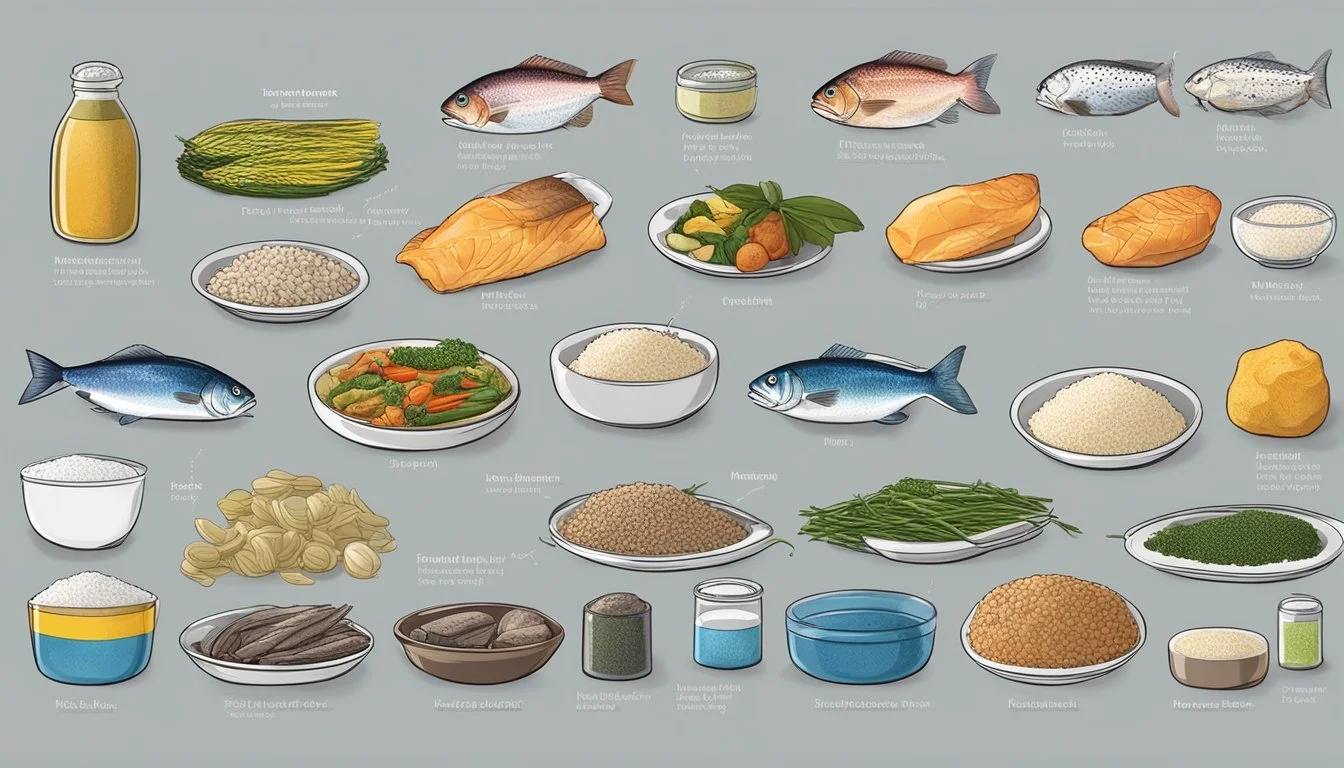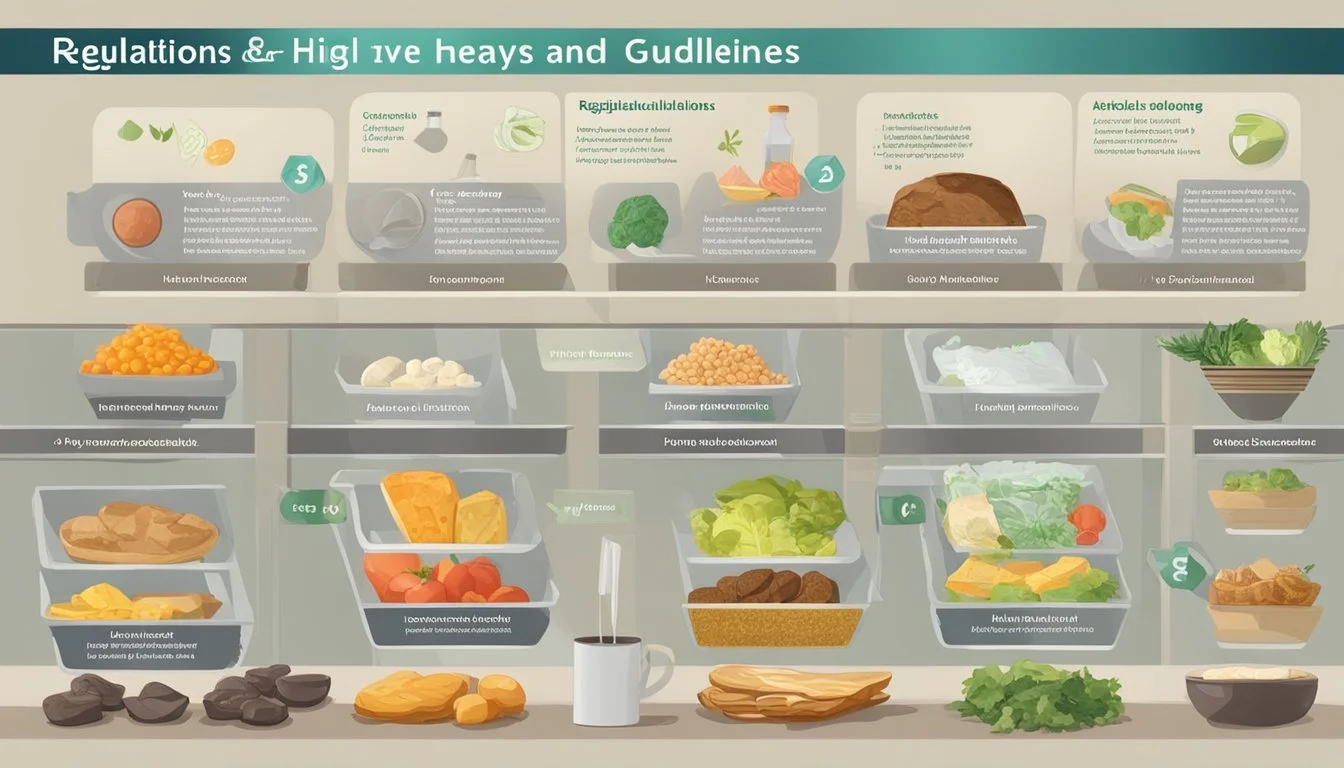Understanding Heavy Metals in Food
Health Risks and Safety Tips
Heavy metals present in foods have become a growing concern due to the potential health risks they pose. Foods can accumulate these contaminants from various environmental sources, leading to unintended exposure through daily consumption.
Understanding which foods are likely to contain significant levels of heavy metals can help individuals make informed dietary choices and reduce potential health hazards. Staying aware of these risks is crucial for those aiming to maintain a healthy diet and safeguard their well-being.
1) Swordfish
Swordfish is a popular seafood choice, known for its firm texture and rich flavor. However, it is also noted for its high mercury content. This heavy metal can accumulate significantly in large predatory fish like swordfish, posing health risks if consumed in large quantities.
Mercury is introduced into the environment through both natural processes and human activity. It gets converted into methylmercury in water bodies, which is then absorbed by aquatic organisms. As swordfish are apex predators, they consume smaller fish, leading to bioaccumulation of mercury in their tissues.
Regular consumption of swordfish can lead to mercury exposure that surpasses recommended safety limits, particularly in vulnerable populations such as pregnant women and children. Health organizations often advise limiting intake to avoid potential neurological and developmental effects.
Despite this, swordfish remains a sought-after delicacy for many due to its nutritional benefits, including high protein and omega-3 fatty acids. A balanced approach to consumption is crucial, ensuring that the risks associated with mercury are managed while still enjoying the nutritional advantages.
2) King mackerel
King mackerel is well known for being high in mercury. Due to the bioaccumulation of mercury in marine ecosystems, larger predatory fish like king mackerel tend to have elevated levels.
This species is often found in the Atlantic Ocean and the Gulf of Mexico.
Despite its rich protein content, consumption of king mackerel should be limited, especially for vulnerable groups such as pregnant women and young children. These populations are more susceptible to the adverse effects of mercury exposure.
King mackerel contains around 0.730 parts per million (ppm) of mercury, making it one of the higher mercury fish compared to others like salmon or tilapia. Regular consumption can lead to mercury buildup in the body, posing health risks.
For those seeking the benefits of fish oils and proteins, opting for lower-mercury alternatives like salmon, sardines, or trout can be a safer choice.
3) Marlin
Marlin is a popular choice among seafood enthusiasts due to its rich flavor and firm texture. However, it is crucial to be aware of its high potential for heavy metal contamination.
Marlin is known to contain significant levels of mercury. This heavy metal can accumulate over time in large predatory fish. This accumulation poses health risks, especially to pregnant women and young children.
In addition to mercury, marlin may also carry traces of other heavy metals like cadmium and lead. Regular consumption of marlin can lead to the buildup of these toxins in the body.
Consumers should be mindful of portion sizes and frequency when enjoying marlin, opting for alternative fish lower in heavy metals when possible.
Understanding these risks helps in making informed dietary choices while still enjoying a variety of seafood.
4) Bigeye Tuna
Bigeye tuna, a popular seafood choice, is known for being high in protein and omega-3 fatty acids. However, it also contains significant levels of mercury, a heavy metal that can pose health risks when consumed in large amounts.
Mercury levels in Bigeye tuna can reach up to 1.816 ppm (parts per million). This is significantly higher than other types of tuna such as skipjack or canned light tuna.
Heavy metals like lead and cadmium have been found in Bigeye tuna samples. These metals can contribute to various adverse health effects if ingested consistently over time.
Because of the elevated mercury levels, it is advisable to limit the consumption of Bigeye tuna, especially for vulnerable populations such as pregnant women and young children.
5) Tilefish
Tilefish is a type of fish known for its bright, vibrant colors. This fish species can be found in the Atlantic Ocean, from Nova Scotia to Florida. Due to its unique appearance, it is often called the rainbow tilefish or the clown of the sea.
Tilefish has a notable sweet flavor, similar to lobster or crab. Despite its appealing taste, tilefish is significant for its high mercury content, making it one of the foods to avoid or minimize in one's diet. According to the FDA, tilefish from the Gulf of Mexico has the highest mean concentration of mercury at 1.123 parts per million (ppm).
Consuming high-mercury fish can pose health risks, particularly for vulnerable groups like pregnant women and young children. Mercury exposure can affect the nervous system and development. Therefore, health authorities advise limiting tilefish consumption to reduce mercury intake.
Regular monitoring of such high-mercury fish is part of broader efforts to ensure food safety. Reducing mercury exposure remains crucial for general well-being, making it important to be aware of which fish species carry the highest risks.
6) Shark
Shark meat is consumed worldwide, especially in Asian countries. Being apex predators, sharks are prone to bioaccumulation of heavy metals, making their meat a health concern.
Studies have shown high levels of mercury, lead, arsenic, selenium, and cadmium in shark tissues. These metals pose significant health risks when ingested over time.
Heavy metal contamination can lead to various health issues, including neurological and developmental problems. Mercury, in particular, is a well-documented neurotoxin.
In some regions, high heavy metal concentrations have been detected in shark species. This underscores the need for monitoring and regulating shark meat consumption to ensure food safety.
Despite the presence of harmful metals, sharks continue to be harvested in large numbers. Over 100 million sharks are caught annually, often without thorough checks for contamination levels. The safety of consuming shark meat remains a critical issue needing more extensive research and intervention.
7) Orange Roughy
Orange roughy, a type of deep-sea fish, is known for its high mercury content. This fish can live up to 150 years, allowing it ample time to accumulate mercury in its body. Long lifespans and a predatory diet contribute to the higher mercury levels observed in this species.
Consuming orange roughy can pose health risks due to its mercury content. Mercury is a heavy metal that can negatively affect neurological development and function. High levels of mercury exposure can be particularly harmful to pregnant women and young children.
The accumulation of mercury in orange roughy is a result of contamination in their environment. Waterways contaminated by industrial processes contribute to the mercury found in these fish. Choosing low-mercury seafood alternatives can minimize exposure and reduce health risks.
Despite its appealing texture and taste, it's advisable to limit the consumption of orange roughy. Alternatives with lower mercury levels include salmon, sardines, and trout. These fish offer similar nutritional benefits without the associated risks.
8) Chilean Sea Bass
Chilean sea bass is known for its rich, buttery flavor and tender texture. This fish, highly prized in culinary circles, unfortunately also has a high mercury content.
The mercury levels in Chilean sea bass are concerning due to the bioaccumulation of this heavy metal as the fish grows larger and older. Methylmercury, a toxic compound, accumulates in its tissues.
According to the FDA, Chilean sea bass contains high levels of mercury, with measurements often around 0.354 parts per million (ppm). This makes it a risky option, especially for pregnant women and children.
Eating Chilean sea bass in moderation is crucial. Regular consumption can pose health risks, such as neurological and developmental issues, due to the mercury content.
Consumers should remain informed about the mercury levels in their seafood choices. Opting for fish with lower mercury levels can mitigate potential health risks while still enjoying the benefits of consuming seafood.
9) Canned Albacore Tuna
Canned albacore tuna is a popular and convenient protein source. It, however, can contain varying levels of mercury, a heavy metal that can pose health risks.
Mercury can impair vision, speech, hearing, and motor skills. The concentration of mercury is higher in albacore tuna compared to light tuna.
Albacore has up to 10 times more mercury than light tuna. Children and pregnant women are advised to limit their consumption accordingly.
Despite its nutritional benefits, consumers should be informed about the potential mercury exposure from regular consumption. Brands and sources often vary, so choosing options with lower mercury content can mitigate risks.
10) Kimberlite Oysters
Kimberlite oysters are known for their higher concentrations of heavy metals compared to other seafood. These oysters often contain metals such as arsenic, mercury, and lead. Their habitat in coastal waters, where industrial discharge is prevalent, contributes to this accumulation.
The biomagnification process is particularly notable in these oysters. Heavy metals move up the food chain and concentrate in their tissues. This process makes them a key species for monitoring environmental pollution.
Consumers should take precautions when preparing and eating Kimberlite oysters. Authorities recommend thoroughly rinsing oysters and using methods to cleanse them overnight. This can help reduce the levels of contaminants before consumption.
Regular testing has shown that zinc and copper levels in Kimberlite oysters often exceed safe limits. These findings highlight the importance of regulating and monitoring seafood to ensure public health safety.
Understanding Heavy Metals in Food
Heavy metals in food can pose significant health risks. They can enter the food supply through various pathways, affecting human health at multiple levels.
What Are Heavy Metals?
Heavy metals are chemical elements with high atomic weights and densities much greater than water. Common examples include lead (Pb), cadmium (Cd), mercury (Hg), and arsenic (As).
These elements are known for their toxicity and potential to cause adverse health effects even at low concentrations.
They can accumulate in the body over time, leading to chronic health issues such as neurological disorders, kidney damage, and increased cancer risk. Levels of toxicity vary among metals, making it crucial to monitor and regulate their presence in the food supply.
How Do Heavy Metals Enter the Food Supply?
Heavy metals can enter the food supply chain through multiple sources. Industrial activities release these elements into the environment, contaminating soil and water.
Plants absorb heavy metals from contaminated soil through their roots. Crops grown in polluted areas can thus accumulate high levels of heavy metals.
Agricultural practices such as the use of fertilizers and pesticides can also contribute to contamination.
Additionally, heavy metals can be introduced during food processing and packaging, further increasing exposure risks. Safety regulations and monitoring are essential to minimize contamination and protect public health.
Health Risks Associated with Heavy Metals
Exposure to heavy metals in food can lead to serious health issues. These risks can be both immediate and long-term, affecting various bodily functions and systems.
Short-Term Health Effects
Short-term exposure to heavy metals like arsenic, lead, and cadmium can result in acute symptoms. Individuals may experience nausea, vomiting, and diarrhea.
Arsenic can cause severe stomach pain and cramping. Lead exposure can lead to cognitive issues, particularly detrimental in children. Cadmium can trigger complications like abdominal pain and vomiting.
Industrial discharges and contaminated food sources are common culprits. Immediate medical attention is crucial to mitigate these effects and prevent further health deterioration.
Long-Term Health Impacts
Prolonged exposure to heavy metals has more severe consequences. Arsenic, lead, cadmium, chromium, and mercury are notorious for their chronic effects.
Arsenic exposure has been linked to skin lesions and cancer. Lead can cause cognitive deficiencies and developmental delays in children. Cadmium is associated with kidney dysfunction. Chromium and mercury can lead to immune system disorders and neurological damage.
Continuous monitoring of dietary intake and environmental factors is essential for preventing chronic exposure and safeguarding long-term health.
Regulations and Guidelines
Governmental agencies establish and enforce standards to protect consumers from the risks of heavy metals in food. These regulations help to define acceptable limits and specify guidelines for monitoring and compliance.
Governmental Standards
The U.S. Food and Drug Administration (FDA) plays a pivotal role in regulating heavy metals in food. The FDA has set interim reference levels (IRLs) for lead, targeting 2.2 micrograms/day for children and 8.8 micrograms/day for women of childbearing age.
In 2024, new metal detection critical limits will be implemented, tightening existing guidelines. The aim is to reduce arsenic, cadmium, lead, and mercury levels in food products, safeguarding public health. FDA’s "Closer to Zero" initiative focuses on minimizing exposure to these contaminants, especially in foods consumed by children.
Safety Measures for Consumers
Consumers can take proactive measures to limit exposure to heavy metals in their diets. Buying diversified food sources reduces the risk of contamination. Washing fruits and vegetables thoroughly before consumption can remove some surface contaminants.
The FDA recommends choosing foods less likely to contain high levels of heavy metals. Parents should be vigilant about the types of foods they offer to children, avoiding those known to have heavy metal contamination. Using water filters that remove heavy metals can also reduce exposure from drinking water.
By following these guidelines and staying informed about updates from regulatory bodies, consumers can significantly lower their risk of heavy metal ingestion.













